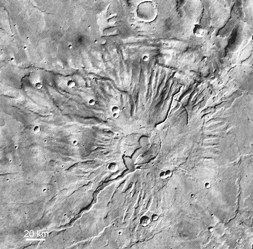
Volcanism has played a more extensive role in shaping the surface of Mercury than scientists had thought. Mercury's lavas also appear to lack iron, writes Adler deWind
Geoscientist Online 7 July 2008
The result comes from multispectral imaging data gathered in January 2008 by MESSENGER, the latest spacecraft to visit the Sun's innermost planet. MESSENGER data has also identified and mapped surface rock units that correspond to lava flows, volcanoes, and other geological features. At the same time, the spacecraft's suite of instruments has confirmed an apparent planet-wide iron deficiency in Mercury's surface rocks.
MESSENGER (short for MErcury Surface, Space ENvironment, GEochemistry, and Ranging) is the first spacecraft to visit Mercury since NASA's Mariner 10 made three flyby passes in 1974 and 1975. MESSENGER, which is operated for NASA by the Applied Physics Laboratory of Johns Hopkins University in Baltimore, will make two more Mercury flybys (6.10.2008 and 29.9.2009) before going into orbit around the planet, 18 March, 2011.
Mercury and MESSENGER form the subject of 11 papers in a special section devoted to the January flyby in the July 4, 2008, issue of the scientific journal
Science. Mark S. Robinson of Arizona State University is the lead author for a paper in the issue, which spotlights data on composition variations in Mercury's surface rocks using their multispectral colours. "We have now imaged half of the part of Mercury that was never seen by Mariner 10" says Robinson. "The picture is still incomplete, but we'll get the other half on October 6." Back in 1974-75, the orbital trajectory that let Mariner to make three passes at Mercury limited it to photographing less than half the planet's surface. This left the rest of Mercury unknown until MESSENGER's arrival in January let scientists begin to fill in the gaps."
Lava plains
MESSENGER's big-picture finding, says Robinson, is the widespread role played by volcanism. While impact craters are common, and at first glance Mercury still resembles the Moon, much of the planet has been resurfaced through volcanic activity.
"For example, according to our colour data the Caloris impact basin is completely filled with smooth plains material that appears volcanic in origin," Robinson explains. "In shape and form these deposits are very similar to the mare basalt flows on the Moon. But unlike the Moon, Mercury's smooth plains are low in iron, and thus represent a relatively unusual rock type."